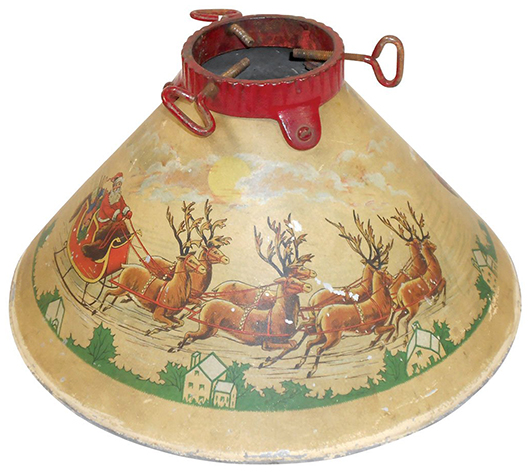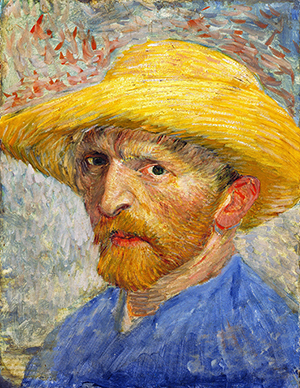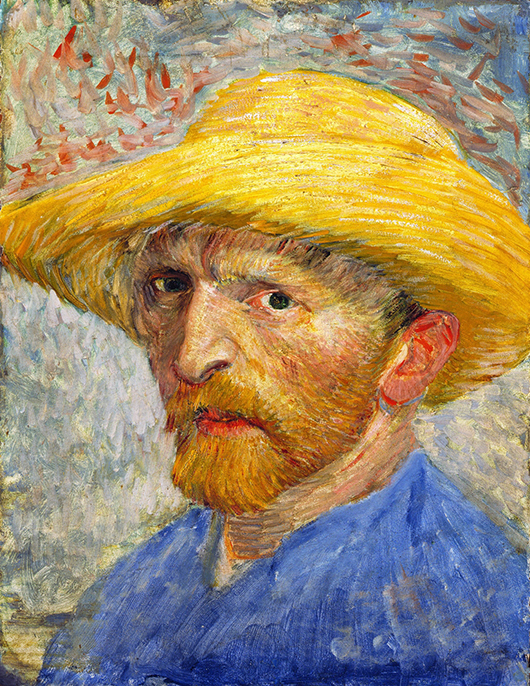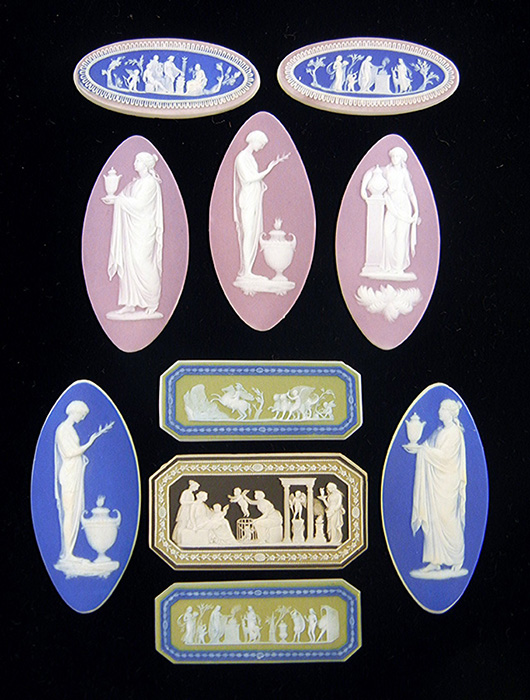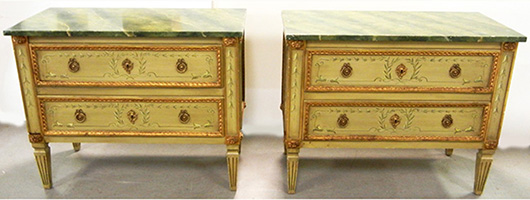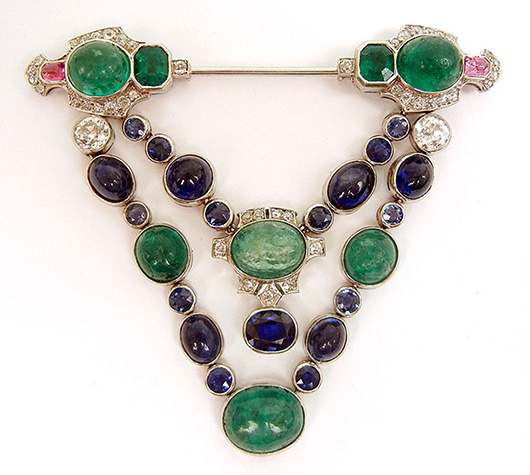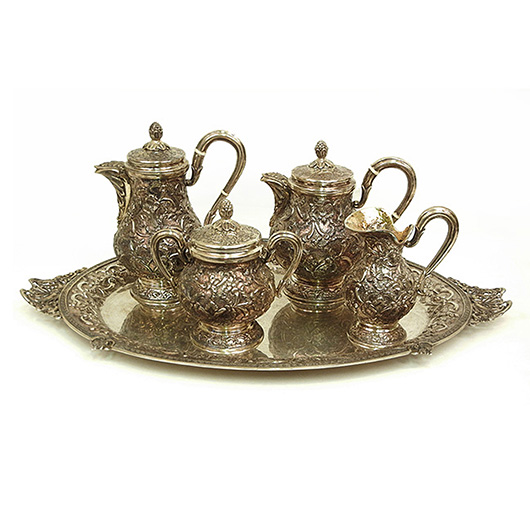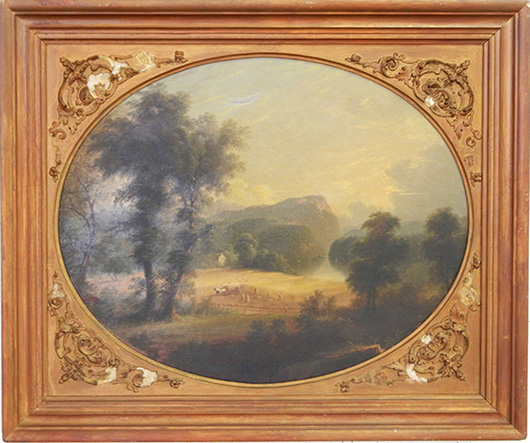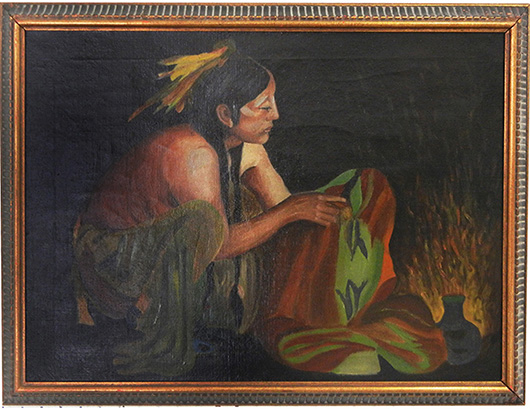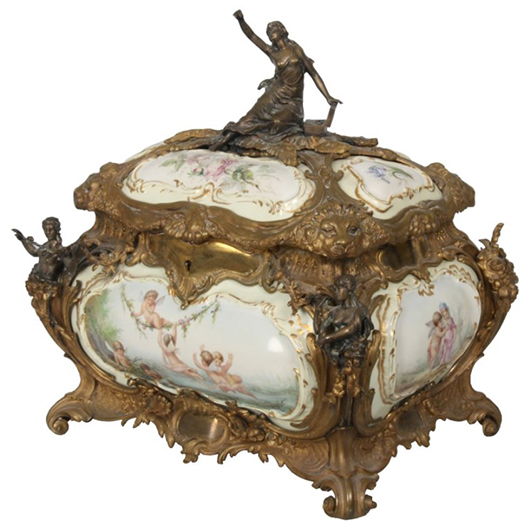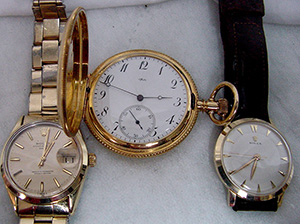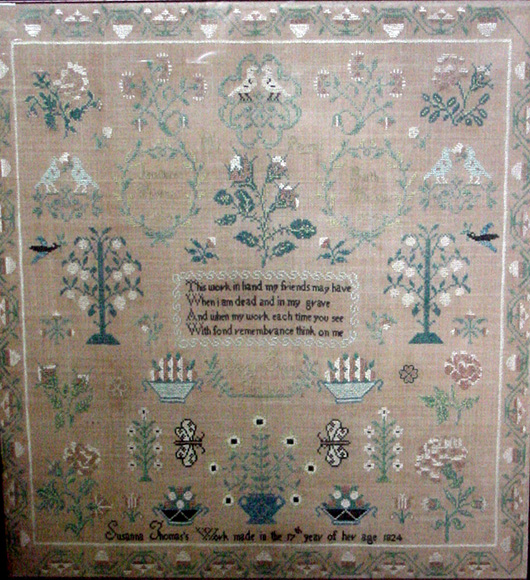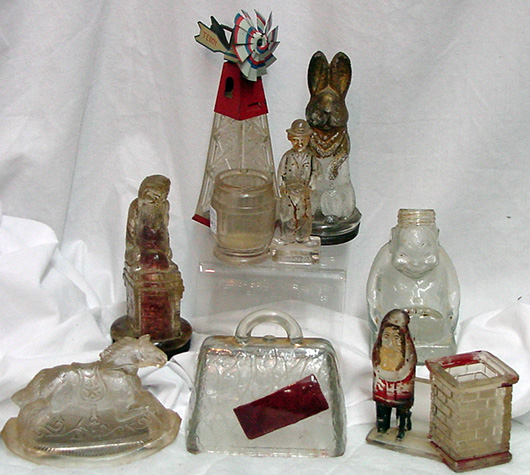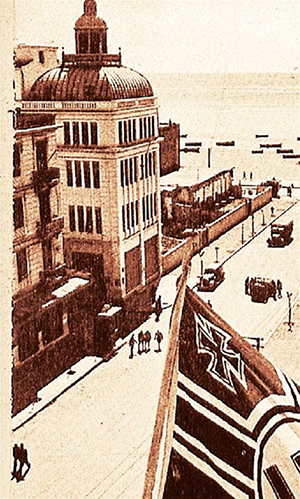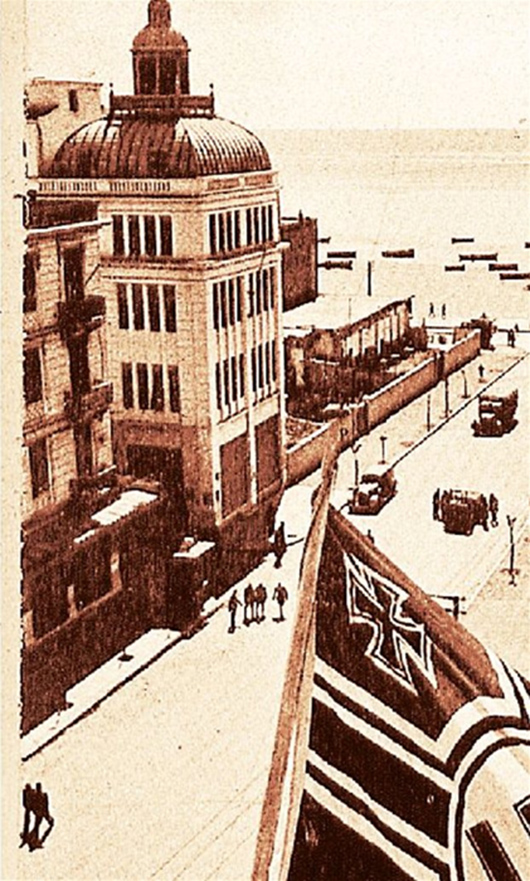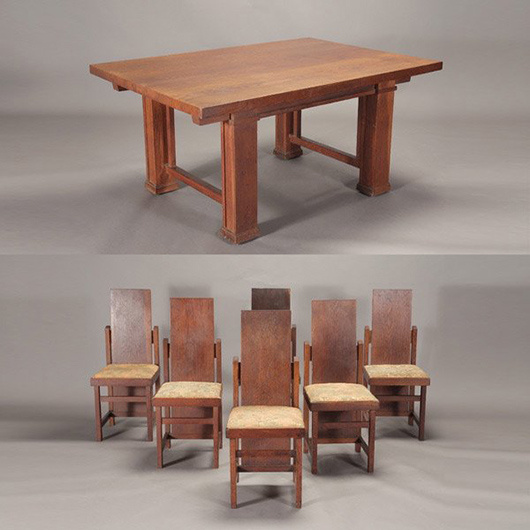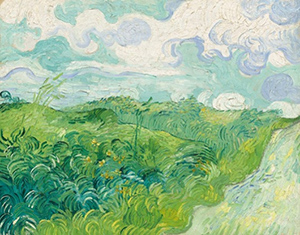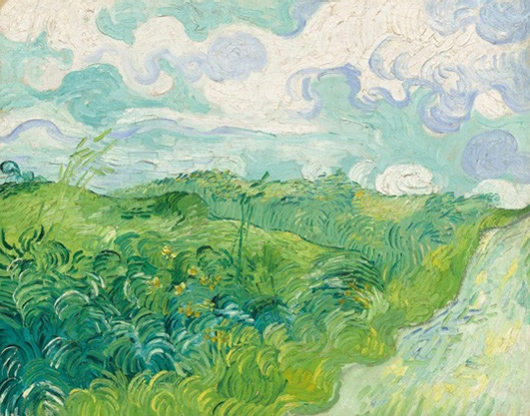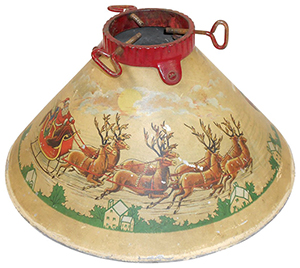
BEACHWOOD, Ohio – Holiday-related collectibles are especially popular if they relate to Christmas, Halloween, Fourth of July, Easter, Thanksgiving, Valentine’s Day and even St. Patrick’s Day. But the most popular holiday for collectors is Christmas.
Families save tree ornaments, toppers, trim and lights, but it is harder to find a Christmas tree stand or fence. Early commercial tree stands were made of cast iron. Three or more legs held a tube large enough for the trunk of a tree and had large screws that dug into the tree trunk. The designs for the iron legs were much like the patterns found on iron stove feet or garden benches. The stands kept changing in style to match dominant furniture styles. By the 1920s, cone-shaped metal stands with lithographed tin pictures of Santa were popular. They resembled lithographed tin toys. Some of these stands were electrified for lights or hid a mechanism that made the tree revolve. Noma, the American company that made strings of Christmas tree lights and developed the bubble light in 1945, had started making stands in about 1926. By the 1960s, the Art Deco aluminum tree was popular, and stands with colored lights were made of shining metal to match. The most expensive antique stands are the early 1900 figural iron stands that look like a small Santa, a group of people or even reindeer. They sell for $200 to $750 each. Noma stands sell for about $200 to $300, and old aluminum stands with lights are $250 to $350. But beware. These have all been copied.
Q: I have a six-pack of 1955 Blatz Holiday flat-top beer cans. The pack has never been opened and it includes cans in all six colors. I think the cans, especially the pink and light blue, are valuable. What is the whole set worth?
A: There are many dedicated collectors of old and rare beer cans. Some would be eager to buy your rare set of 1955 Blatz holiday steel cans. In addition to light blue and pink, the set included green, chartreuse, dark blue and orange cans. Beer, previously sold in bottles, was first sold in cans in 1934. The cans were made of steel until 1958, when aluminum cans were introduced. Blatz Brewery opened in Milwaukee in 1846 and continued to operate under various owners until 1958, when it was sold to Pabst. The brand name is owned by Pabst today, too, but the original Blatz brewery has been converted to condos. We have seen a single green 1955 Blatz holiday sell for more than $250, so your complete set could top $1,000. To sell your cans, do some research and find the right market. Contact experts at the Brewery Collectibles Club of America (BCCA.com) and at Breweriana.com.
Q: I have a 6-foot-tall silver metallic Christmas tree that’s at least 50 years old. Does it have any value? Should I sell it?
A: Aluminum Christmas trees were popular in the 1960s. The first ones were made by the Aluminum Specialty Co. of Manitowoc, Wis., in 1959. The trees have wire branches wrapped with aluminum strips to represent “needles.” Early trees had collapsible tripod bases. Later, revolving bases were made, some with music. The trees came in various sizes and colors, but silver was the most popular. Since lights couldn’t be put on aluminum trees, most people used a lighted revolving color wheel at the base of the tree. Millions of aluminum trees were made in the 1960s by several manufacturers. They went out of fashion by the end of the decade and could be picked up at garage sales for just a few dollars. Reproduction and new aluminum trees are being made. Collectors have recently become interested in the old aluminum trees, and prices have risen. Some sell for over $100. If you like the tree, you may just want to keep it and display it during the holidays.
Q: About 25 years ago, I bought an “M.I. Hummel” signed print of the Madonna for $12. It’s 12 by 18 inches. My children had it framed for me. My daughter tried to search online for information about Hummel prints, but all she could find were figurines. Can you help?
A: Sister Maria Innocentia (Berta) Hummel (1909-1946) is most famous for the Goebel figurines based on her artwork. But before and after she became a nun in 1933, she drew and painted pictures that were also published as prints. The signature she used on yours is her convent name and means the original painting was done in 1933 or later. Your print would not sell today for much more than you paid for it, even with the frame.
Q: My husband’s grandfather’s uncle, named Otto Stark, was of German descent. He lived much of his life in the Indianapolis area and belonged to the “Hoosier Group.” We have a few pieces of his artwork and wondered if they would be of any value.
A: The Hoosier Group was made up of five Indiana artists whose paintings, murals and portraits of Indiana people and places were featured in many exhibitions and public buildings in the “Hoosier State.” The name “Hoosier Group” was first used to refer to them in 1894. Otto Stark (1859-1926) was born in Indianapolis and is known for his impressionist landscapes dating from the late 1800s and early 1900s. He started out as a woodcarver’s apprentice and later worked as a lithographer. Stark studied art in France. He opened a studio in Indianapolis in 1894 and later taught art. His oil paintings are offered for $2,000 to $4,000, and his watercolors for $400 to $1,000.
Tip: Store fragile Christmas tree ornaments in plastic zip-lock bags. Be sure there is some air in each bag when you zip it. The air bubble protects like bubble wrap.
Terry Kovel and Kim Kovel answer questions sent to the column. By sending a letter with a question, you give full permission for use in the column or any other Kovel forum. Names, addresses or email addresses will not be published. We cannot guarantee the return of photographs, but if a stamped envelope is included, we will try. The amount of mail makes personal answers or appraisals impossible. Write to Kovels, Auction Central News, King Features Syndicate, 300 W. 57th St., New York, NY 10019.
CURRENT PRICES
Current prices are recorded from antiques shows, flea markets, sales and auctions throughout the United States. Prices vary in different locations because of local economic conditions.
- Lefton Christmas girl figurine, muff & holly, 1950s, 3 3/4 inches, $20.
- Hull Magnolia vase, footed, handles, matte glaze, c. 1946, 8 1/2 inches, $80.
- Sevres inkwell, birds, branches, double well, black trim, 19th century, 3 x 8 1/2 inches, $120.
- Mickey Mouse bowl, alphabet, Mickey on train, Bavaria, c. 1932, 7 inches, $170.
- Flying Nun lunchbox, Sister Bertrille flying, children, metal, Thermos, Aladdin, 1968, $330.
- Steuben glass owl, big eyes, 5 x 4 inches, $360.
- Tea table, tilt top, Chippendale style, mahogany, Kittinger Furniture Co., 28-inch diameter, $450.
- Porcelain group, four children collecting flowers, Meissen, 6 1/2 x 6 inches, $600.
- Cane, wooden, ivory skull handle, 36 inches, $960.
- Effanbee Patsy Mae doll, composition, muslin, sleep eyes, human hair, box, 1935, 27 inches, $1,570.
Ralph and Terry Kovel, syndicated newspaper columnists, best-selling authors, avid collectors and national authorities on antiques, hosted the HGTV series Flea Market Finds with the Kovels. Watch the Kovels’ HGTV shows to become an expert on almost anything you see at a flea market. DVD sets of Seasons 1 and 2 (12 episodes each, plus a DVD of the final episodes of Seasons 1-4.) Available online at Kovelsonlinestore.com for $59.90 plus $4.95 postage, by phone at 800-303-1996; or mail to Kovels, P.O. Box 22900, Beachwood, OH 44122.
© 2013 by Cowles Syndicate Inc.

ADDITIONAL IMAGE OF NOTE
